#the rule of funny being the main rule of a world above that of coherence and plausibility truly is a double edged sword
Explore tagged Tumblr posts
Text
One of the biggest problems of writing that Frasier post is that the logic of 90s comedies is not real life logic. It's not just that you can just pick which exaggerated thing to believe more (and sometimes you need to outright pick between two mutually excluding canon facts), but also the degree to which you believe anything. Which is fun for theorizing but also terrible for theorizing because to argue one way or another you need to create the fiction that the coherent narrative you are pointing out has value of truth in a universe where the value of truth is the rule of funny.
#This I'm saying about Frasier applies to others btw of course#like The Nanny suffers from those very same problems too#plus prestige tv in the early 2000s really messed with people's understanding of the extreme make-up-as-you-go quality of older tv#It's acknowledged with Cheers for the most part#But like yes Maris becomes more and more of a monster as seasons go by because the creators did take a direction after a few seasons#but seasons 1 and 2 at the very list (of Frasier I mean) are VERY undecided on whether they are going to save Niles and Maris' marriage#or take the Daphne route#And there's so much about expected genre tropes and the structure of sitcoms involved in those decisions!#the rule of funny being the main rule of a world above that of coherence and plausibility truly is a double edged sword#Like I'm confident I can write a narrative as to why Maris is actually not a monster at all in the first seasons of Frasier#And that at the very least some of the jokes are not meant to be taken seriously#but then to prove that I would have to point out all the times the narrative shows Niles mirroring Maris' bad traits#which of course are also ruled by the rule of funny!#Niles worrying about Maris ogling the pool boy while he's been ogling Daphne#Niles talking fondly of how one of their favorite past times when they were just married#was to laugh at people who wore white after labor day!#someone else could of course believe THESE are the ones played more for comedic effect#and believe the meanness of Maris as more real#(again still talking those early seasons)#and like it's not that serious#horrible people can be entertaining and comedy capitalizes on that#it's the emotional equivalent to the physical violence in old cartoons#it's not supposed to be realistic and taking it to be so is silly#on the other hand reimaging how the characters and the story could go in different directions#if the story WAS a drama is deeply compelling#but then how to convey you are just having fun theorizing the dramatic possibilities of unserious comedy#without coming across as if you were taking the comedy to be a drama#see the tough spot I'm in
10 notes
·
View notes
Note
Honestly as refreshing it is to see your sane takes on things over here I can’t imagine how the possible heat you‘re getting looks like.
At the same time I know you‘re above those but still… sanity comes with a price nowadays…
Actually, I'm getting almost none. I think leftists are generally cowardly and non-confrontational. I'm better equipped both mentally and emotionally to fight a battle of attrition. I'd be willing to bet even that leftist who wanted to act all edgy and complement me for being a funny right-wing troll has blocked me by now (unless they are one of the few Liberation Army fans who haven't). It's rare to know a leftist who can take too much dissent, even though I can see the leftist dominant culture being pushed constantly and just be like, "Eh...."

I think it is. On Wednesday, the Supreme Court heard an argument about whether states have the right to ban puberty blockers for children. The arguments of the transgender activists fell apart and made them look stupid. No, being transgender isn't an immutable characteristic. No, gender affirming care doesn't reduce child suicide rates. Yes, puberty blockers lead to sterilization in most cases. Yes, other countries are scaling back treatments for children based on lack of evidence it does any good.
It's going to take until summer to get a definitive ruling (which is just insane. Damn government..) but I'm optimistic that once the states have the right to ban child castration and mutilation, then it will open it up to pass a nationwide ban.
Matt Walsh did an interesting take on it.
youtube
His intro explained well why normies have been strong armed into accepting radical left wing bullshit for so long.
The Supreme Court held oral arguments yesterday in one of the most important cases in this country's history. It's a case that will decide whether under the US Constitution states are allowed to outlaw child sterilization and mutilation in the name of gender Ideology. Now in any other generation this question would not have made it to the Supreme Court in the first place. The question itself would have been bewildering to anyone who heard it for the simple reason that sterilizing castrating and mutilating children is one of the greatest evils imaginable. Even some of the most barbaric civilizations throughout history wouldn't even contemplate it. You don't need a law degree to understand that. You don't need a convoluted analysis under the equal protection Clause of the Constitution. You just need to be a moral person. You need to be sane and have a basic working understanding of human biology.
Now one of the main reasons that we've come to this point is that trans activists have successfully intimidated everyone else into silence. Trans activists aren't capable of making coherent or rational arguments in defense of child butchery because child butchery is indefensible, but they're very capable of shouting down anyone who opposes their ideology. Predictably that's what they tried to do to me when I spoke yesterday at the rally outside the Supreme Court. Here's part of my remarks in front of the capital just to give you an idea of what the scene was like.
Here it is. This case is about the rights of children. It's about the right of a child to be protected from this. That's what it's about. Children have the constitutional right, the human right, the God-given right to live and grow and learn about themselves and the world without being indoctrinated and exploited by people who reject the fundamental realities of existence. Children have a right to go through phases to have moments of and discomfort in their own bodies just like every generation of children before them without that being seized upon as a pretense to do to their bodies now.
As you can probably tell trans activists were shouting into megaphones the entire time that I was speaking. It happened to the other speakers too. They were doing it the whole time. Trans activist showed up in large numbers outside the court with the intention of making it difficult for us to speak and be heard and that's what I expected what happen. It is what happened. Leftists are very good at mobilizing protesters to show up and be as obnoxious as possible. They're certainly much better at that than we are but they're still losing this fight. They're losing in the state legislatures. They're losing in the culture and after yesterday's oral arguments it's pretty clear that they're about to lose in the Supreme Court as well.
Every indication we have at this point is that a majority of the justices will vote to uphold Tennessee's ban on child mutilation. If that happens it won't just protect millions of children in Tennessee and many other states have implemented similar bans will also clear the way for a national ban on these grotesque practices which have ruined the lives of untold numbers of children.
The reason we can be confident in the outcome of this case is that one by one each of the arguments from the Biden DOJ and the ACLU collapsed under questioning from the conservative justices in the majority. When the liberal justices tried their best to defend gender ideology somehow, they only managed to make matters even worse. We predicted that something like this would happen. When they can't shout you down, when they actually have to construct arguments and respond to objections trans activists tend to fall apart pretty quickly. That was the case um for the ACLUs lead attorney in this case Chase Strangio a female who quote 'identifies as a man'. To get some idea of the kind of person Chase Strangio is she's posted a variety of emotionally charged unhinged content on social media over the years....
#leftist culture#gender affirming care#experimenting on children#experimenting on humans#matt walsh#U.S. v. Skrmetti
1 note
·
View note
Text
The Contendings of History and Seth
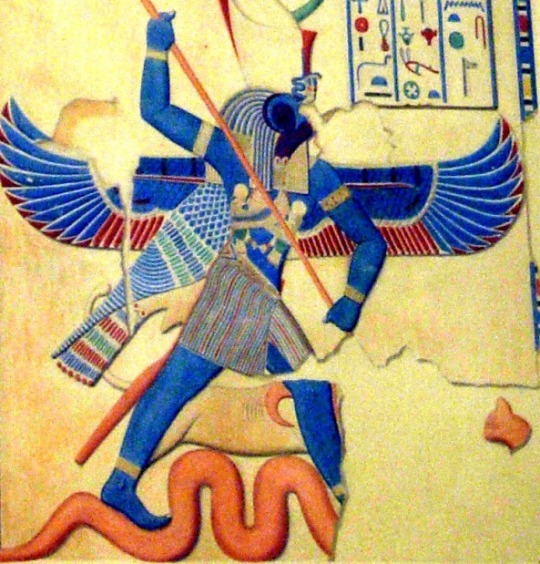
Seth as a serpent-slayer (MET) It's safe to say that the myth of Osiris is one of the only non-Greek myths to enjoy a comparable degree of recognition in modern popculture. There are few direct adaptations, sure, but the core narrative is well known, and as a result works themed after ancient Egypt use Seth as a villain almost without fail if only the premise allows the use of fantastical elements. However, in this article I will instead examine the other side of Seth, and especially his role as a protagonist of myths in his own right, including the historical circumstances of this development. While I mostly want to introduce you to a little known but fascinating world of heroic(?) portrayals of Seth, naturally I will also cover Seth's later loss of relevance and complete vilification to explain why it survived as the dominant tradition.
Early history of Seth
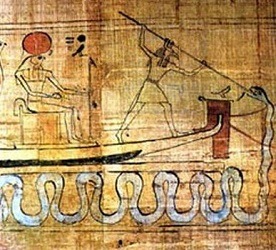
Seth protecting Ra from Apep (wikimedia commons) From the dawn of recorded history Seth's status in Egyptian religion was ambivalent, and it continues to be a topic of heated debate among researchers what degree of popularity he enjoyed in particular very early on. Some aspects of Seth character, like his evident interest in both men and women and whether it reflects broader Egyptian cultural norms (or if it’s merely yet another way in which Seth was an outsider among gods and men, as the author of the first monograph dealing with Seth proposed in the 1960s) are likewise a hotly debated topic. Seth was associated with many animals, such as the hippopotamus and the crocodile, but his main symbol is the sha or “Seth animal” which is regarded as either a mystery or a fictional creation, and in Egyptian texts inhabits zones inhospitable to humans. Seth was called “the god of confusion” by Herman Te Velde (the first writer to dedicate a monograph to him) and while this opinion has been since called into question, it is undeniable that it’s hard to form a coherent image of him. In addition to various versions of the well known myth mentioned above there are other instances of combat between Seth and Horus (most likely initially a distinct myth combined with the narrative about Osiris’ death and resurrection at a later date) and of Seth as a menace to the established order. Some of the Pyramid Texts present even the human followers of Seth as enemies to be conquered (which is held by some researchers a mythical memory of strife between local kings before the unification of Egypt). . However, there are also texts where Seth is a rightful member of the Ennead; where he and Horus act in harmony as protectors of the ruler; where he assists pharaohs in their resurrection in the afterlife; and even to Seth as one of the gods responsible for returning Osiris to life. A recurring motif in texts dealing with the afterlife in particular is a description of Seth offering a ladder to the dead who can reach some destination themselves. Mentuhotep II of the XI dynasty seemingly had Seth and Hathor depicted behind his throne in art; Hatshepsut described Seth positively as well. Personal names invoking Seth are known, too; and as established by Willam Berg in his studies of a different ambivalent deity, “children are not called after spooks.” Seth's ambiguous character made him ideal to represent The Other in Egyptian culture – the foreigners, especially these arriving from the Levant, their culture, and generally “un-Egyptian” traits. In that capacity, he functioned as an “ambassador” or “minister of foreign affairs,” to put it in modern terms. Or perhaps a foreigner in his own country, so to speak. As a result, he came to be associated with a group of deities which, while part of the official pantheon, had their origin outside Egypt.
The Ramessides and foreign gods
Generally speaking, there were two primary sources for foreign deities incorporated into Egyptian religion: Levantine trade centers like Gebal (Byblos in Lebanon) or Ugarit (Ras Shamra in Syria); and Egypt's vassal/enemy/ally/very occasional ruler Nubia (roughly corresponding to present day Sudan). Libyan influence was smaller, and to my knowledge there is no evidence of any major impact of Egypt's other trading partners (Punt, located near Horn of Africa, and Minoan Crete; the latter absorbed many Egyptian influences instead, though) or enemies (like the Hittites) on religion. The peculiar history of Seth is related to the the first of these areas. Early researchers saw the “Syrian” deities as worshiped at best by slaves or mercenaries – they didn't fit neatly into the image of Egypt presented by some royal inscriptions: an unmovable, unchanging and homogeneous country, a vision as appealing to absolute rulers in the bronze age as it was to many 19th and 20th century researchers. However, the truth was much more complex, and in fact some of the best preserved accounts of foreign cults in Egypt indicate that the process was in no small part related to the pharaohs themselves. For example Ramses II in particular was an enthusiast of Anat, as evidenced by statues he left behind:

Ramses II and Anat (wikimedia commons) He also named his daughter Bint-Anat (“daughter of Anat”) and his favorite pets and possessions bore Anat-derived names too. Not only only Ramses II himself, but the entire XIXth dynasty – the “Ramessides” (a term also applied to the XXth dynasty) - was particularly keen on these imported deities. Curiously, one of its founders was named Seti - “man of Seth,” and Seth was seemingly the tutelary deity of his family. The well known case of Ramses II's red hair might be connected to this – this uncommon trait was associated with Seth. As a result of the Ramessides' rise to power Seth became one of the state gods in Egypt, alongside heavyweights like Amun, Ptah or Ra. However, it's also safe to say that he was popular in everyday cult among commoners, as evidenced by finds from camps for workers partaking in various construction projects.
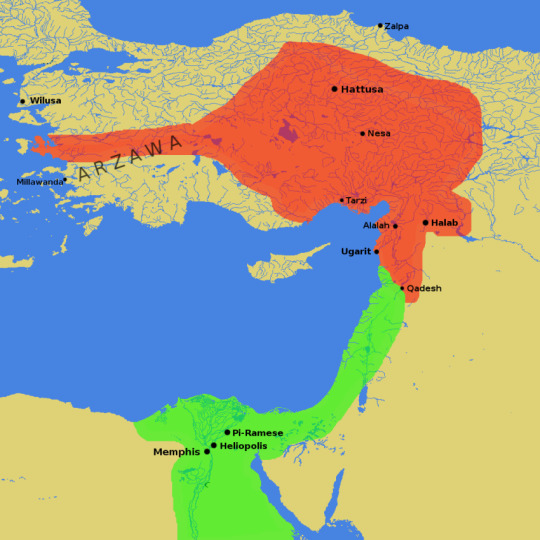
Part of Egypt of the Ramessides at its maximal extent (in green; wikimedia commons) During the discussed period, Egypt was as the peak of its power, both military and cultural; the “other” recognized Egypt's power. Weaker states in the proximity of Egypt paid tribute, while the more distant fellow “superpowers”of the era (the Hittites and the Mitanni, rivals of Egypt in Syria and the Levant, and the more distant Kassite Babylon) bargained with Egypt for dynastic marriages, luxury goods or craftsmen. While some foreign rulers didn't necessarily get that the pharaohs might not want to play by their rules and expressed frustration with that in their letters sometimes (see a particularly funny example below), overall the relations were positive, and resulted in a lot of interchange between cultures.

(source) The incorporation of foreign deities into Egyptian pantheon was a phenomenon distinct both from the well known practice of interpretatio graeca and from the monumental Mesopotamian god lists, and foreign gods were adopted rather selectively. Some researchers propose that the incorporated deities were often chosen because their sphere of influence wasn't covered by any native god. For example, Astarte (more accurately Ashtart or Athtart, considering the Ugaritic orthography; however the Greek spelling is used in literature to refer to the Egyptian version and I'll stick to that) was associated with horses and chariot warfare. As the animal wasn't known in Egypt in the formative period of the state, it wasn't among the symbols of any local deity; at the same time chariots were a prominent component of the Egyptian military at the height of its power, and as such required a deity to be put in charge of it. Six deities of broadly “Syrian” origin are usually listed among Egyptian gods in modern scholarly literature: Anat, Astarte, Resheph, Houron, Baal (the Ugaritic weather controlling one) and Qadesh. Of these, four were pretty similar to their original versions. Qadesh is a complex case as it's uncertain if such a deity existed outside Egypt – it's possible she developed as a combination of a divine title (“the holy one”) and the general Egyptian perception of foreign religion. Some scholars in the past asserted she is simply Athirat/Asherah but this interpretation relied on the false premise of Athirat forming a trinity with Anat and Ashtart and the three of them being the only prominent goddesses in cities like Ugarit. There are also curiosities like Chaitau, a god with Egyptian name (“he who appears burning”) but attested only in sources from Levantine cities (though ones written in hieroglyphics) and in magical formulas of similar origin. Baal is the most puzzling case: simply put, it's clear Baal was introduced to Egypt. It's clear Baal was depicted in Egyptian art. It's even clear that Egyptians knew that Anat and Astarte were deities from Baal's circle back at home, and that Baal was tied to a narrative about combat with the sea. And yet, it's not easy to say where the Egyptian reception of Baal ends and where Seth starts. Baal's name was even written with the Seth animal symbol as determinative. When exactly did this identification first occur is unknown: while it would be sensible to assume the Hyksos, a Canaanite group which settled in Egypt and briefly ruled the Nile delta, are responsible, there is some evidence which might indicate this already happened before.
Baal and Seth
Baal was a natural match for Seth: Seth represented the foreigners, Baal was the most popular god of the foreign group most keen on settling in Egypt; Baal has a somewhat unruly character in myths; both rule over storms and have a pronounced warrior character. Additionally, both of them were depicted as enemies of monstrous serpents. Baal was identified with Seth in Egypt, but in turn Seth became more Baal-like too. So-called “Stela of year 400” depicts an entity labeled as Seth more similar in appearance to Baal due to the human face and Levantine, rather than Egyptian, garb:
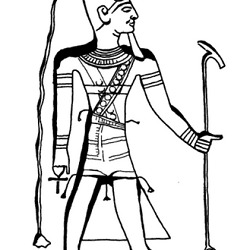
(source) It is well known that the main myth of Baal, in Ugarit the first part of the “Baal cycle,”describes his combat with the sea, personified by the god Yam, seemingly described both as humanoid and serpentine. In Egypt, this narrative was associated with the composite Seth-Baal, and a fragmentary version is recorded in the so-called Astarte papyrus. Curiously, it was actually discovered long before the Baal cycle itself – however, it only became a subject of in depth studies in the wake of the discovery of Ugarit. There are also many similarities to the Hurrian myth “Song of the Sea,” known only from fragments, and to the Song of Hedammu from Hittite archives. While in the Ugaritic version Baal fought the personified Sea against the wishes of the head god El, in the Egyptian version the confrontation happens because the Ennead fears Yam, who threatens to flood the earth and demands tribute, much like the Hurrian Sea. Before Seth properly enters the scene, we learn about how Ptah and Renenutet, a harvest goddess, appeal to his associate Astarte (as already noted before viewed as Ptah's daughter in Egypt), hoping she'll act as a tribute bearer. Astarte is described as a fearsome warrior; however, she is not meant to fight Yam herself, but merely temporarily placate him. She seemingly strips down and brings offerings – this is, once again, closer to the Hurrian than Ugaritic version, where Shaushka, an “Ishtar type” goddess like Astarte, seduces the sea monster Hedammu in a similar way. It is not clear if Yam is interested, though - in fact he appears to question why Astarte isn’t dressed (possibly mocking what must’ve been a humiliating situation for a warrior deity, I’d assume). Eventually, Seth arrives and presumably fights Yam, likely with Astarte's help - the rest of the papyrus is too poorly preserved to decipher, but as indicated by the foreign equivalents Seth and Astarte win. This is confirmed by the Hearst Medical Papyrus, imploring Seth to expel illness from the treated person just like he vanquished the personified Sea. The Ugaritic version of the myth doesn’t include a tribute scene among surviving fragments, though it’s worth pointing out that the Ugaritic Ashtart/Astarte cheers on Baal during his battle against Yam and berates him for not acting quick enough, which is easy to interpret as hostility caused by a similar episode. Many researches assume that it existed among the lost fragments of the Baal Cycle tablets, though this is for now purely speculative. A variant of the myth of Seth and Horus - The Contendings of Horus and Seth - presents a further curious case of Seth-Baal syncretism, this time incorporated into well established Egyptian myth rather than an imported foreign one. Seth and Horus compete for the right to rule after Osiris' death. Ra thinks Seth is the better option to nominate as a successor because Seth killed Apophis on his behalf, but a few other of the elder gods disagree and try to delay the process by insisting to ask various deities to provide their expert opinions. These generally favor Horus much to Ra's annoyance, but he can't go against them so he insults Horus (calling him "feeble and weak-limbed" and criticizing his hygiene) but doesn't stop his rise to power. The semi-humorous portrayal of Ra is rather unusual; in addition to showing annoyance with other gods, at one point he vanishes, and only agrees to return because Hathor lured him out. It seems Horus' mother Isis insults Seth in response to Ra's comments. Seth, offended, refuses to partake in the divine assembly unless Isis leaves; Ra orders that and the gods gather again without her. However, Isis disguises herself and asks Seth who should inherit first, a child or a brother who can provide for himself (and is a foreigner), to which Seth replies that the former; this was a trick, obviously, and Isis holds it as proof that Seth forfeited his right to rule, which Ra accepts. After multiple chaotic tribulations (including the [in]famous lettuce episode as well as Horus decapitating his mother because he decides she doesn't do enough) Horus is re-declared king but Ra, implored by Ptah (otherwise absent from the myth) gives Seth two wives (eg. Anat and Astarte; this solution was suggested already earlier by the gods providing the opinion; some authors question if they are meant to be Seth’s wives or merely allies, much like the relationship between Baal, Anat and Ashtart in Ugarit is considered debatable) and the storm clouds as his new domain. He is to strike fear into hearts of men, but will also get to be treated as if he were Ra's own son. Considering the emphasis on storm and the mention of Anat and Astarte, it's pretty clear to me that Egyptians essentially invented their own Baal backstory meant to integrate the foreign tradition with their own by recasting Baal and Seth as the same entity. The text is however unusual because of its humorous tone – the gods insult each other, act ineptly and all around hardly provide an inspiring example. Perhaps the focus on Seth made this possible. As a final note before I'll move on to times much less prosperous for Seth it's worth to mention that not only Baal but also other foreign gods were at times equated with Seth. The Libyan god Ash was conflated with him in the western oases, while treaties with the Hittites assign the name of Seth to various members of their pantheon, including the Baal-like Tarhunna (equivalent of Hurrian Teshub) but also the sun goddess of Arinna.
Demonization of Seth
While in the late bronze age Seth greatly benefited from his role as a god of foreigners, in later periods this has proven to be his undoing. Egypt couldn't maintain its power forever, and eventually fell to the Assyrians, who showed little respect for local culture and looted Thebes. While the Assyrian domination was only temporary, it severely damaged the country, and a spiritual scapegoat was needed to reconcile the carnage with the idea that Egypt was a land chosen and protected by the gods. The change seemingly occurred under the rule of Psamtik – in a new version of the myth of Seth and Horus, Seth not only lost decisively, but also was punished afterwards, and religious texts spoke of a “rebellion”of Seth. Seth was never associated with Ashur, the head god of the Assyrians, before, but in Egyptian imagination he was blamed for bringing the invaders under “his” command to ravage and subjugate the country. A mythical text has Isis implore Ra to punish Seth for robbing temples, much like the Assyrian armies did. Even later accounts tell various tales about Seth being punished, either gruesomely (a few texts recount massacred of towns belonging to Seth) or humorously (for example in one text Thoth makes him impotent with a spell) and exiled from among gods. There's evidence that the worship of Seth, previously commonplace, came to be abhorred and depictions of Seth were destroyed or altered. A famous example is a Seth statue converted to look like Knhnum or Amun instead:
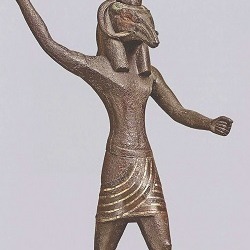
Seth no more (wikimedia commons) A late relief from Edfu, from the Ptolemaic times, seems to indicate that even Seth's role as a guardian of the solar barge was lost: Seth, depicted as a hippopotamus, was defeated by Horus from the solar barge of Re. However, while Apep is usually depicted as huge and menacing, hippo Seth is tiny and pathetic.

Seth as a tiny hippo representing the forces of chaos (wikimedia commons) Curiously, despite the official policies, which continued under Ptolemaic rule, it seems that until the 2nd century CE, Seth continued to be popular in the Dahkleh oasis, possibly even serving as the main deity there. Sadly due to lack of research I am unable to provide any more detailed information about that.
Closing remarks
Even further demonization of Seth is evident in the fact that the Greeks and Romans referred to Seth as Typhon, leaving no room for ambiguity of interpretation. As the Greek accounts of the late version of Seth were all that was known for centuries due to ability to read hieroglyphic writing vanishing with the advent of new religions, it remains dominant in media today. Perhaps it would be beneficial to leave some room for the serpent-slaying hero Seth hanging out with foreign deities in modern works, though? Surely his peculiar outsider status is even more appealing to modern readers than it was to the public of the Ramesside period.
Bibliography
N. Ayali-Darshan, The Other Version of the Story of the Storm-god’s Combat with the Sea in the Light of Egyptian, Ugaritic, and Hurro-Hittite Texts
G. Beckman, Foreigners in the Ancient Near East
M. Dijkstra, Ishtar seduces the Sea-serpent. A New Join in the Epic of Hedammu (KUB 36, 56+95) and its meaning for the battle between Baal and Yam in Ugaritic Tradition
T. J. Lewis, ʿAthtartu’s Incantations and the Use of Divine Names as Weapons
D. Schorsch and M. T. Wypyski, Seth, "Figure of Mystery"
D. T. Sugimoto (ed.), Transformation of a Goddess. Ishtar – Astarte – Aphrodite - especially the chapters ‘Athtart in Late Bronze Age Syrian Texts by M. S. Smith and Astarte in New Kingdom Egypt: Reconsideration of Her Role and Function by K. Tazawa
H. Te Velde, Seth, God of Confusion: A Study of His Role in Egyptian Mythology and Religion
P. J. Turner, Seth - a misrepresented god in the Ancient Egyptian pantheon? (PhD thesis)
C. Zivie-Coche, Foreign Deities in Egypt
128 notes
·
View notes
Text
The Worst of 2019
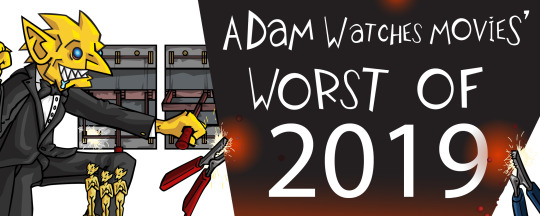
I had to follow-up my “Best of 2019″ list with its opposite universe counterpart but before I give the movies that made me suffer another lashing, let’s make a couple of things clear. I’m not a paid professional and even if I was, all I would be is a film critic. Making movies is hard. Nobody in the industry aims to do a bad job - there are much easier ways to make a living. Even though I might’ve hated these films with a passion that still smolders now, I’ve got mad respect for anyone who decides to put themselves out there and put together a movie. At the end of the day, your work is going to live on. You made something millions will see. Me? I’ll ultimately fade away. Take this into consideration as we single out the movies that tried and failed, sometimes spectacularly.
10. Cats
Cats is the kind of movie that doesn’t come around often. It’s actually kind of fascinating to watch, or it would be if it weren’t so boring. Rebel Wilson (who was destined to have a movie on this list when she starred in The Hustle) plays a cat who unzips her skin to reveal an outfit… above her skin again? She leads a choreographed troupe of singing mice and cockroaches that fill you with terror and confusion. It’s as if they’ve been scaled so the actors could scoop them up and swallow them whole - as cats would do - but because human proportions are so different from cat’s the objects and other animals they interact with change size from scene to scene. Meanwhile, Idris Elba is prowling around with his coat all open, his non-existent junk exposed to all who want to see. Our main character is so bland and unmemorable she makes no impact on you whatsoever. There’s magic in a plot that’s composed almost entirely of introductions - which might make it accurate to the broadway show but not entertaining as a movie -, dodgy special effects in every frame, lame jokes coming from the left and the right… and yet, I don’t hate this film like I do the others on this list. In fact, a part of me even admires Cats.
The thing is, had this movie worked, it would’ve been hailed as genius. It didn’t so it’s being ridiculed but I have to give it points for its ambition and willingness to take chances. That means a lot in a year in which every single one of the top ten grossing films were sequels, remakes or expansions of already-existing properties.The gamble didn’t pay off, but Cats had the guts to walk up to the plate.
9. Dumbo
I was tempted to lump The Lion King and Aladdin along with this tale of a baby elephant that learns to fly while a family of circus performers learn that the big circus tycoon played by Michael Keaton is a meanie. Few of the Disney “live-action” remakes do anything to validate their existence. They’re just feeding you what you can already watch at home for free because you probably already own the originals on home video or you have Disney+. I’m going to single out Dumbo as the worst because it actually tried something different and failed spectacularly. This means we can expect all future Disney remakes to take as few chances as possible.
8. Jay and Silent Bob Reboot
There are other movies I could’ve put in this spot (see the Runner-Ups section below for examples) but I had to consider the experience as well as the movie itself. Jay and Silent Bob Reboot is an unfunny comedy that walks into the room as if it’s going to marry your mother and be your new father. It makes fun of the very thing it’s doing. This might make it appealing to members of the “View Askewniverse” cult but not to me. Whether you’ve been brainwashed by Kevin Smith or not, it’s impossible to sit through the painful bonus material which follows the film, particularly the interviews conducted by Jason Mewes. The actor displays no charisma whatsoever while asking questions you don’t care about to people who obviously don’t want to be on camera. I get what Smith was doing; he was trying to give his fans more than just the movie but anyone in their right mind should’ve seen the bonus footage and burned it.
4. Dark Phoenix
What a disappointing way to end the X-Men franchise. Dull until the very end and then interesting for just enough time to make you realize you didn’t just dream it all, the movie was a bad idea from the start. We haven’t known the young version of the X-Men long enough for this story to mean anything and the choices made to make this story more faithful to the comics makes you wonder if you stepped into the wrong movie. Even before seeing Dark Phoenix, I thought people were being too harsh on The Last Stand. They did a lot of things wrong in 2006 but they had the good sense to leave out the aliens. It’s not great but it’s been somewhat redeemed since because its plot advanced the series and meant something in the end. Even if Disney had considered keeping this franchise alive while it was acquiring Fox, this is such a mess they now have no choice but to reboot the whole thing.
4. Jexi
Jexi feels like it just escaped from a time capsule. Even when it would’ve been new, it wouldn’t have been funny. This had no business appearing in theatres and watching the trailer again reminded me of why I hated it as much as I did. If you suspect you have mutant powers that just need to be unlocked by a traumatic or life-altering event, barricade your doors and start playing this movie. You’ll want to escape so desperately, you might suddenly develop the ability to bend space and time.
6. Rambo: Last Blood
This 5th entry in the Rambo series didn’t even have the guts to commit to being a proper conclusion. The titular character appears to succumb to his wounds as the picture closes… only to get up and go find medical attention during the end credits. Senselessly gory and violent, its depiction of Mexico leaves a bad taste in your mouth.
5. Shaft
No one was asking for this movie, not even fans of the original Richard Roundtree films or the 2000 Sam Jackson reboot. It tired story attempts to introduce a new version of the classic blaxploitation character to a new audience. In the process, it makes you hate the two “heroes” we follow through a generic plot filled with offensive humor. The only good thing about Shaft is that it prompted me to check out the originals.
3. My People, My Country
The Farewell made me think a lot about how we should view other cultures, particularly China. In it, Awkwafina’s Billi is caught in a moral dilemma when she learns her beloved grandmother is dying and that her family is keeping the secret from sweet Nai Nai. You go in thinking the American-raised woman is going to do the right thing by tearing the charade apart but it’s not long before you realize this scenario isn't that simple. When it comes to My People, My Country, I am going to judge. What’s the moral of this movie again? Give up your life, your dreams, your family for the sake of a country that sees you as nothing more than an expandable pion? If that weren’t bad enough, the movie’s so dull it’ll be an epic struggle to stay awake. Whose idea was it to have an entire segment of this anthology dedicated to the engineers who ensured the mechanism that would raise China’s flag in 1949? It’s as exciting as it sounds.
2. ¡Ay, mi madre!
The worst part of this list is that I know how few people reading will be able to relate. ¡Ay, mi madre! wasn't released theatrically in North America, but movies release “Straight to Netflix” have become such a big deal I’ll make an exception to my usual rule of disqualifying direct-to movies from this list. In terms of filmmaking, this is the worst movie I’ve seen in a long, long time. It’s more technically inept than anything else on this list by far. The comedy is so unfunny it’ll make you question your life, the actors are not convincing even before they open their mouths to speak and the ending might as well be a big middle finger towards the people watching. It ha no ending, almost as if they cobbled together the few salvageable strands of footage someone scooped out of the trash into something vaguely related to “coherent”. Remember the name so you know never to click “play” if you happen upon it like I did.
The Runner-Ups
Simmba
I was deeply offended by this Bollywood film but technically, it’s a 2018 movie so I decided to only include it here. It’s loathsome but admittedly, my hatred for it has somewhat subsided since I saw it. Don’t ask me why. This movie sucks.
Playmobil The Movie
This is what we thought we were going to get when they announced “The Lego Movie”. Terrible songs, a lazy plot that makes terrible use of the property it’s advertising, unfunny jokes, and a lack of imagination guarantee this film is destined to make everyone involved regret the day it was released.
Hellboy
Yet another failed superhero movie that enthusiastically sets itself up for a sequel when it’s so obvious to everyone watching that there isn’t going to be one. The one thing it’s got going for it is a pretty cool scene towards the end where demons escape into our world and begin tearing civilians to pieces. To get to that, you must sit through endless scenes that bash you over the head with a mallet marked “Rated R”. Gallons of blood and intestines spilling onto the floor, doesn’t mean the movie is meant for adults. This was written by a teenager disguised as a grown-up.
Gemini man
They waited all these years for the de-aging technology to get where it is now… for this story? Someone should’ve pointed out to director Ang Lee when he was getting ready to film that training doesn’t alter your DNA. Why waste millions cloning Will Smith when you could just raise a normal kid and train them to be an assassin? Ultimately, the movie isn’t really all that bad. It’s watchable but it’s such a big disappointment it needs to be taught a lesson.
Replicas
I’m giving this one a break because no one saw it. I also think it’ll play better at home, where you’ll be free to make fun of it or verbally abuse the loopy plot aloud while your friends listen. If there’s a movie this year that was “So bad it’s good”, it’s this one.
After
At least “Twilight” had its original take on vampires and some danger mixed into its romantic triangle to keep things theoretically interesting. This film started off as - I kid you not - a “One Direction” fan-fic. The drama it serves up will have you howling like a werewolf flying through laughing gas. On the upside, a sequel is coming. In fact, the teaser is scheduled for today!
1. Unplanned
This was the most uncomfortable movie experience of 2019. Most of the Christian propaganda films don’t seem to put much effort into their production - they’re preaching to the choir so why should they? - but 2019 had Breakthrough, which was quite good. It showed these movies don’t have to appeal solely to the churches who will buy tickets en-masse. This movie is ridiculous, gory like a horror film, misleading, and phony. It did have what is undoubtedly the most outrageous and unintentionally funny dialogue of the year, however. “Fast food outlets look to break even on the hamburgers they sell. That’s all they do is break even ... Do you know where they make all their money? The french fries and soda. Low cost, high margin items. Abortion is our fries-and-soda.” Are we sure this was based on a true story? If so, I don’t know why the director decided to edit out the scenes in which Cheryl (Robia Scott) takes the buckets of aborted fetuses home to cook them. I think it would’ve really driven home how evil her character is. I felt dirty sitting in the theater next to people who ate this up.

#movies#films#reviews#movie reviews#film reviews#film criticism#simmba#Playmobil: The Movie#hellboy#gemini man#replicas#after#cats#dumbo#aladdin#the lion king#Jay and Silent Bob Reboot#jexi#rambo: last blood#shaft#dark phoenix#My People My Country#¡Ay mi Madre!#unplanned
7 notes
·
View notes
Note
Ok. So what do you think of the latest chapters of fairy tail 100 years quests? What what's happening to characters? I think you're so possed that you even stopped reading more
Hoo boy... *Cracks knuckles* We may be here for a while.
So before I start, let me make clear that I actually keep up with 100YQ, though not for any actual interest anymore. I now stay with it for ironic enjoyment. Because I could say EZ has dumb stuff, but at this point, if you’re Hiro Mashima’s main audience, its fine. No, 100YQ is unique in that it has WTF moments that transcend just the FT fandom sensibilities.
Before I dig in, I’m gonna lay out some formatting rules because we’re cover A LOT. Im gonna be fair and split this up into positive and negative aspects of the series. Because I at least try to be intellectually in what I do.
To avoid from going on tangents and jumping around, I’m gonna be going in chronological order of events. Now this will not be an overview of the series up to this point because that’s stuff I’ve already talked about. Instead I’m gonna start from the point this went from genuine interest to ironic interest. That begin the Whited Out FT Guild.
Positives:
The concept of the wood dragon god having a kingdom on his back is really cool world building. Its actually something that I really liked about the Sea Dragon God as well. Having a realm reliant on the dragon as well as a reason to revere them. What with the water dragon god controlling the tides while wood dragon god is the supporting the city on his back actually makes them seem like god figures and adds to the lore of the world of Earthland in a way that Ishgar and Alvarez sorely failed at.
Laxus punching out Kyria. Petty yes, as Kyria is my least favorite dragon slayer. However a lot of Whited out FT mages were getting jobbered like crazy or just given unceremonious defeats. So Laxus actually seeming like an obstacle was good.
The cat twist with Touka is actually a funny bit of trolling and was one of the few times there was effective foreshadowing with Touka having a tail. (Too bad it was suck in the meandering Gajeel plot.)
The Dragon Eater guild is a much better final villain army than Spriggan 12. The 12 had little structure as to who was the stronger members, resulting in multiple Spriggans feeling like such major disappointments.
Most Mashima Villain organizations tend to broken up like this: Boss->Special Units (I.E Spriggan 12, Nine Demon Gates, Element 4)->Fodder Units.
No one cares when the fodder of a villain group is beaten as they’re just faceless minions. However, when you get to the special unit, that’s wheen there are actual obstacles and the villains start becoming more like characters. However, Hiro has been bad at this when he’s dealing with bigger organizations.
He never had to worry about telling you which member of the villain group’s special unit were more powerful than the others. Due to working with units composed of low amounts of characters, such as Team Lyon, Element 4, and Death’s Head.
You could say that all were roughly around the same power threshold. However, where the spriggan 12 royally failed was there were 12 of them in that unit and they were all just given the blanket term of being on the same level of the number 1 wizard saint. Yeah... that’s a check so large that Hiro could not cash it.
Hiro even seemed to retroactively acknowledge this by stating that August, Irene, and Larcarde were the three best to cover his ass for the fact that all the spriggans seemed to be jobbered far easier than ones supposedly equal to the number 1 saint.
However, the Dragon Eaters are opponents we’re gradually introduced to over the storyline and we actually see a demonstration of what a group of them can do, instead of 1 just trying take on all of team Natsu at once. We see that Skullion’s team is roughly equal to Team Natsu, giving us a gauge for the Dragon Eater strength, but then we get both Wraith and Nebal, underlings not part of Skullion’s thre man team, implying that are of a weaker variety and thus serving as a stepping stone to fight Skullion. But also introducing us to the Black Dragon Slayer Cavalry. Members above Skullion’s team that give us an idea if when they show up what the audience should expect of their strength level.
There’s a reason why in One Piece why Yonkou opperations have so many categories. You’re not gonna care about the minor thugs, but by making a distinction between the Headliners and the Disasters in Kaidou’s crew, you’ve made it so that we the audience will not feel disappointed if a Headliner is beat by a weaker character like say Usopp but still know that they are more than a foot soldier so this win meant something.
Now time for the negatives:
The concept of White Out is not awful, and is actually a fairly interesting concept for a villain motivation in FT. However, the White Witch is one of the most transparently evil characters in the series, thus you know that she’s doing this morally ambiguous action because she’s evil. Imagine if this were about humans or royals who feared the growing power of mages. Or a disillusioned mage with the concept of people like Zeref or the GMG, where is seems like magic is endless and how that’s a threat to the world. No, White Witch really seems like she wants to be this grand manipulator and actively enjoys calling heer whited out people, puppets.
However, there’s also the fact the whiting out doesn’t make too much sense. Some characters seem like mind controlled puppets like Juvia, while others are basically the same except their evil now like Gajeel, Mira, Elfman, Laxus. And some are dumb jokes like Jellal.
So there’s no consistency to this brainwashing. Only other time I’ve seen a mind control plot like that in media before is Yugioh GX. Sometimes people act like they’ve been brainwashed into something different like Alexis. But then people like Bastion and a lot of the gag members of the society like Rose and Bob act as if they’re not affected by anything.
Yeah, this white witch plot feels distractedly ripped off from the society of Light from Yugioh GX.
The concept of Team Natsu vs FT in the vain of the fighting festival arc is dumb narratively from two standpoints. First from a story standpoint in the idea that why the battle of FT arc was opportunity, due to the fact they were all willing to fight to free the frozen girls. Which allowed for others to show shades to their motivations Like Alzack willing to mow through his other comrades for Bisca or Thunder God Tribe assisting in protecting Laxus so he’s the last man standing. There’s a tangible reward on th line that motivates the characters to act as do.
Here, the characters are clearly fighting against their will because of an intangible force. This white magic makes them slaves and are fighting because “white doctrine.” Something they only believeebecause brainwashing. As such, you want to see Natsu and gang beat them up to stop the white witch and free them. There’s no force or intrigue that makes the audience care about both sides like seeing Alzack vs Jet and Droy because you know they both want to save their partners but only one can. Instead people only care because a surface level of “friend turned evil” device. It takes the B and C list cast of the FT guild and makes them props.
And from a meta standpoint, there is no tension, due to the fact this is a post final battle with acnologia Team Natsu. The team is bounds ahead of so many guild members like Macao, Reedus, Max etc. that the only real threat is the S class mages. So that makes that big page spread of evil FT in cult robes dull as only like 3 of them are gonna actually matter.
Then there’s Wraith. Nebal was a boring an generic crazy guy is unimpressive, Wriath was actually really interesting at first. Is ghost magic allowed for an interesting fight and his possession actually having limitations on how effective it was made for a cool skill.
But then the reveal about him and Makarov. I eye-rolled at that point, but then I saw the previews and was like, maybe this’ll be the best thing to come out of this series. Everyone wants to know more about past FT around team Makarov’s time.
But all the potential of young Makarov and young Porylusica and the rest of their team is put on fast forward as they’re all suddenly thinking about leaving. But maybe the reveal with Wraith could be interesting. I saw a lot of good theories like Wraith was Makarov’s half brother or Wraith was the son of Makarov and Porylusica who was killed by Ivan.
Well... Any theory would’ve been better than Wraith was some random ass mage and when they say he a Makarov are related its because the bonds of FT that is real family and transcends death itself.
...Gag me...
And and Wraith just fucks off into the afterlife. Because we can’t actually end a fight because of the protagonist’s ingenuity. No, the villain just kills themselves because feels. Isn’t that right August and Irene?
In conclusion
That’s my thoughts as briefly and coherent as I could make them. So if you wanna know my feelings on 100YQ, it can basically be summed in FT being FT. If you expected more, you’re gonna be disappointed. But if you genuinely love the world and character regardless of Hiro’s writing, you’ll probably still enjoy it regardless of what I’m saying
7 notes
·
View notes
Text
Good Stuff’s Best of 2018
WARNING: I just want to say cheers to you for making it through another year. I send you best wishes for next year to be fruitful. Thank you, take care out there, and enjoy.
Dedicated to Stan Lee, Stefán Karl and Stephen Hillenburg, the number ones of children entertainment
Bow Whacka Wow, playas and players. 2018 gave us quite a lot to consume while society continues to fumble like a Tumblr update. While hopefully the chaos has died down for the final weeks of the year, I’m counting down the best cartoons/animations I’ve seen and loved this year in no particular order. Only two rules, no sneak previews of future projects (sorry 101 Dalmatian Street and MP100) and no potential entries from last year’s list (sorry True). With that said, roll it....
10. UNIKITTY!
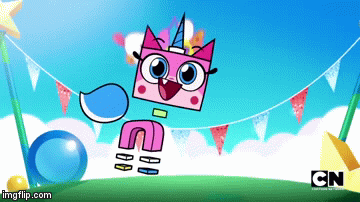
I love the Lego Movie. I’ll potentially like the sequel. I like Unikitty. She got a show, and it was a great show to start off the year. Upbeat, colorful, off the walls sometimes, perfectly capturing the spirit of the eponymous character. I’m glad the other characters are just as enjoyable, I never get tired of the theme song, every episode had me smilin’ one way or another, it’s just a quality bottle of positivity juice. Don’t know how else to explain it, Unikitty, the show and character, just makes and continues to make me smile.
9. POP TEA-- SIKE!

This anime ain’t nothing but unfunny randomness and skits with a forgetful arc in the first and final episode. I don’t get it, never gonna get it, so I don’t want to get it! MORE LIKE POOP TEAM EPIC, ‘nuff said. Which is why the actual number nine is....
9. BOB EPIC TEAM
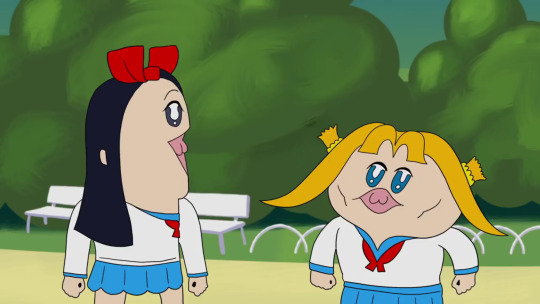
Honestly, there is something endearing about the way Bob Epic Team presents itself. The simplicity and variety of its animation is remarkably good and makes it feel timeless sometimes. The comedy works in a way that gives you a clear grasp on the two characters while letting them do whatever they want. The surrealism of this is fun to think about, showcasing a hedonistic philosophy that rivals that of Epicurus. The duo’s chemistry is what especially got me, as they felt like the best of friends, potentially love birds *wink wink*. This anime was just creative in every sense of the word and, like Unikitty, it was a great anime to start of the year.
8. CRAIG OF THE CREEK
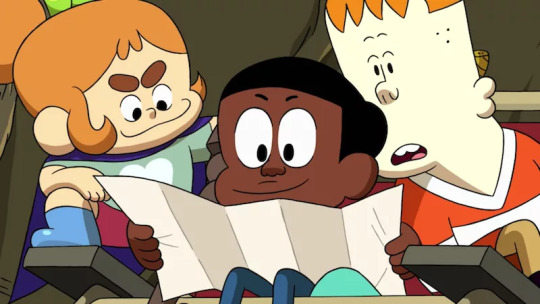
The ska is RAH. I honestly find this to be the loose spiritual successor to Hey Arnold and Recess. Like the playground, the creek is a well fleshed out setting with the many characters that hang there, from the TAZ trio to the loving witches of the creek. Though I will say the best episodes are when we get insight on the main three’s personal lives with their families and when the characters themselves go through a personal trial to understand themselves a little better. The shows thrives in the theme that the creek is a place where you can enjoy getting your hands dirty and work towards something you want, even if it doesn’t add to any concrete long term benefit beyond learning a thing or two about yourself and others. And I say for somebody that relates to Craig as a character, that’s a welcoming thought that the show has yet to perish. And the ska is a welcome choice of music, IMO.
7. THE EPIC TALES OF CAPTAIN UNDERPANTS
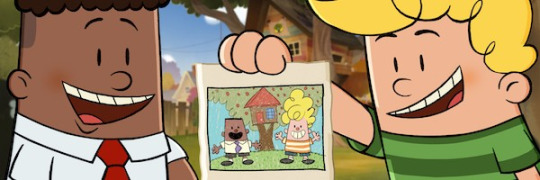
It’s funny in how a little over a year of getting a movie, Captain Underpants gets an animated series with not only original stories in lieu of just animating the already printed stories, but puts it all in a format similar to reading a book with a sardonic narrator and separating the plot of the episode into chapters with subtitle cards; one of the first I’ve seen do this. But really, a “Captain Underpants cartoon” is something I can’t say would turn out bad, and I’m right as this is a show that revels in what made CU great in the first place. George, Harold, Melvin, and Mr. Krupp/Captain Underpants are all great characters with the additional supporting cast providing welcome life to the world. Every Incredible Violence Chapter is brilliant in their own right, and while I wasn’t a fan of the ending they had for the season, it’s great that almost every episode is self-contained, boosting its replay value. Honestly, any compliment I have for this was already said in my review of this and the movie, so I’ll just say this too was faithful to its source material and benefited heavily for it.
6. GARY AND HIS DEMONS

Rick and Morty done better. BOOM, send tweet! It is safe to say that this was quite the sleeper hit and I can’t help but say it’s lowkey one of the best adult cartoons this year next to Ballmastrz and Final Space. And while I certainly appreciate the other two *hint hint* this one got a step above on the grounds that it works as a comedy and a solemn tale of a chosen hero that stumbles through years in the office life. It’s improv humor feels natural and it can be as melancholic as Bojack Horseman without making it all too deep like so; has a great balance of both. Main man Gary, unlike Rick for the most part, is a guy that’s both reasonably reprehensible yet pretty relatable. Not to mention, while it was bittersweet, it had a very satisfying finale to where I feel like this was a complete series all together. With a rough art style that compliments it’s tone, this was a series that surprised me in its sharp quality.
5. APPLE & ONION
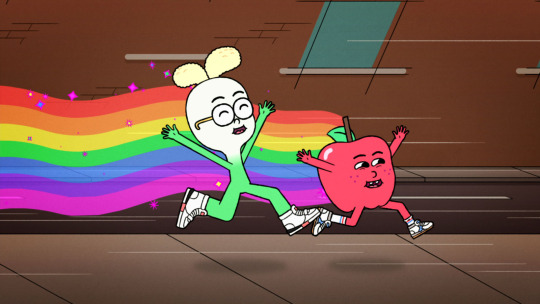
I’ll admit. Initially wasn’t a fan of it as it felt like a knock-off to Regular Show (may it rest). Just had a duo of bros living together, doing mundane labor while coming up with impromptu tunes along the way. Then again, I was gladly proven wrong because the charm of it generally being a simple show, even with every person being food, somehow more regular than Regular Show. Every song they make is upbeat and catchy, all of the characters are endearing, and with only 10 episodes, each one was well paced and had quality writing to the point where I teared up a couple times. It stinks that this and Summer Camp Island have generally been receiving the shaft this year after their premieres, but I'm just glad that they haven’t been truly forgotten by CN and are getting more episodes next year. Plus, I love food and this show is about food. Debate over.
4. LEGEND OF THE THREE CABALLEROS
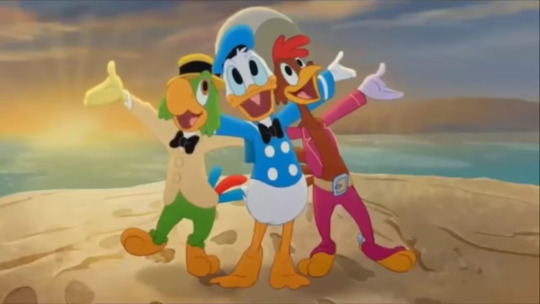
I was familiar yet never saw The Three Caballeros, ironic since Donald is one of my favorite Disney characters. But then, out of the blue, I found this and I was stunned, amazed, confused, nonetheless invested. It has a bumpy start, but it’s a joyous adventure from that start to end. The look of it is something I’ve rarely seen in animation since... freakin’ Wakfu. I love Xandra and I was glad to see her be an active player on the team. The villains are such a hammy delight. And Jose and Panchito were very lively and entertaining foils to Donald’s cynic nature while all three work as well together like the 3 stooges. Donald himself gets a great arc of his own throughout the season. And the theme, HO MY GOD I LOVE THIS THEME! It’s a damn shame Disney hasn’t released this already (since it’s all online already) because this series is much better than it has any right to be.
3. GOLDEN WIND/VENTO AUREO

I say, the beauty of Jojo’s Bizarre Adventure is that regardless of what part you start from, you’re enthralled into its world and ya feel compelled to dig into it more. Parts 3 was what got me into Jojo, like most I bet, but it was part 5 that got me “Oh yeah, this series [just] works on more than level”. The characters are what keep me hooked, regardless of Crunchyroll refusing to give their stands proper English names [Zipper Man, CR?], Fighting Gold and Freak ‘n You will never get old, and David Productions putting great effort into the small details and giving life and style to the original manga. I’ll just say, as one who’s read and loved the manga, this anime has not ceased to keep me impressed and guessing for more.
2. INTO THE SPIDER-VERSE

Funking superb, you afro having web-slinger. I hate to say it, but 2018 didn’t have the most impressive line-up of western animated features. Most were average, entertaining sure, but nothing felt like 110% was given. Until Spidah-Man came on the scene and I was like “WIG...

The only major problem I have with this film, besides a bit of slow pacing, is more of a missed opportunity where the stakes of getting the Spidermen back to their dimensions before dying felt like an afterthought. Then again, that’s ALL I have for problems. It looks fantastic. The action is smooth, coherent, and satisfying to see. The tiny details and comic book aesthetic of it was a blessed touch. I loved almost every character here. Nick Cage and John Mulaney. The fact that it has so much yet was able to juggle it all blew my mind. Even the post credits scene made this such a love letter to the wall-crawler. This film was refreshing to say the least and the central theme behind the idea of Spider-Man made this as great of a superhero movie as Infinity War and Lego Batman. Just saying, this better make its budget back and THEN SOME. It deserves it.
1. HILDA
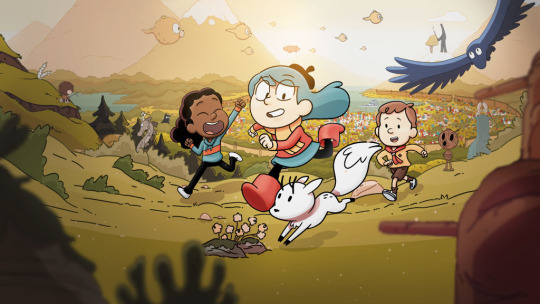
Netflix, we’re not on good terms mind you, but ya done did it again. This is honestly one of the few shows that I genuinely took my time with as opposed to binging it, because binge watching is a devil in itself. Like the Spider-verse movie, it got the style of its source material down to cozy colored T with its autumn color palette and etched lining in the characters. Like the Captain Underpants series, while having a grounded arc of Hilda journeying through the city life and her colliding wildlife, each episode can be generally be enjoyed on their own. Like Gary and His Demons, it felt like a complete season and the fact it’s getting a season two made things all the better. But above all, it was a generally peaceful yet captivating fantasy cartoon to watch with incredible animation, an endearing main character, amazing looking folk creatures of all sizes and powers, and a cuddly deerfox for a pet. I say this is to the fall what Harvey Beaks was to the spring, and if I can compare a show to Harvey Beaks you know you’ve achieved greatness. Like True and the Rainbow Kingdom, gives you a moment of honest bliss and happiness that can influence your outlook on looking forward to better things because like Hilda herself, you push forward and have some fun exploring.
Just saying, I cannot stress this enough this is NOT my number one favorite show of the year, hell of all time. THAT goes to....
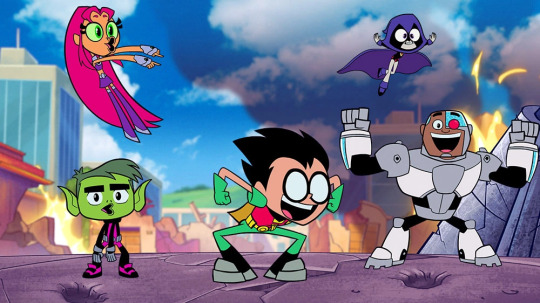
1. 👏TEEN 👏TITANS 👏GO, BABEEEEEEY!!
ONCE AGAIN, Teen Titans GO reigns supre-- Huh, what’s that? Oh my god, you’re serious?! The Number One is

TOTAL DRAMARAMA OUT OF NOWHERE! IT IS NOW CARTOON NETWORK’S ‘NEW FAVORITE SHOW’.

THE STREAK *DING DING DING* IS OVER
#best of 2018#cartoons#anime#animation#Good Stuff#cartoon network#disney#reviews#long post#unikitty#pop team epic#bob epic team#cotc#craig of the creek#the epic tales of captain underpants#captain underpants#gary and his demons#apple and onion#legend of the three caballeros#the three cabarellos#into the spider verse#golden wind#vento aureo#Hilda#hilda the series#hildafolk#TTG#total dramarama#awesome#ye
412 notes
·
View notes
Text
Léon (Léon: The Professional)

Léon The Professional, in Europe simply known as Léon, is considered one of the best action films ever made. Yet at the same time It's a bit of an oddball. It clearly has all the elements of an action film, but it isn't built on action the entire time.
Rather this is an action film, that builds itself entirely around It's two main characters. There's a clear evolution in both It's characters over the course of the film, they evolve emotionally just as real people do.
The two main characters, aren't automatons. They're human beings, they're allowed flaws and imperfections. They're allowed emotions and feelings, here emotions and feelings aren't as in so many action films seen as something that makes the hero weak, or not even particularly strong, just simply human.
And that's what I loved about the film. It is an action film, but the action is rather something complimentary, It's first most about the characters their relationship and their evolution.
Any impressive action scene in the film, is not random and arbitrary, It's been motivated by the characters, it never feels like they're just fishing for impressive visual effects. Yet Léon, is still a beautiful, very aesthetically pleasing film with some gorgeous effects, that simply stay imprinted in your mind after you've seen it, It's quite unique.
Another thing that makes it special and unique, is that at times it feels like one of those charming, quirky French dramas, where It's all about the people in the film and in the next it can feel like one of those big American action films, just a tad less dramatic, but more schizophrenic, and It's marvelous.
There's a scene where it seems Léon and Mathilda are drinking glasses of milk in what could be an apartment in Montmartre in Paris. The next moment it looks like you're in Manhattan, It's very hard to explain, but it almost feels like a French drama hiding under the surface of an American action or the other the other way around.
You have elements of both French, European cinema and elements of American cinema, It's a perfect blend of both countries in one film. And in fact it makes perfect sense, and is a lot less chaotic than it sounds. Luc Besson the director is French and opted to film both parts in Paris and some parts in New York. So you have a Parisian New York, or a New Yorkian Paris.
And It's something that's unique, when you're watching the film you know It's not New York like you've seen it before, yet it feels utterly real and coherent, so real in fact that you think you could just step into the film and walk around in that city.
Now I've given the film a lot of praise, in what I've discussed so far, but funnily enough I had never seen it until yesterday. It's one of those films that I've heard that It's considered as one of the best films of all time, and also as one of the best action films ever made.
At my home we actually have it on DVD, so when my eye fell on it I just had to see it, it always felt like I was missing out on some big secret that everybody else was in on and I just didn't want to feel that way anymore. And I am immensely glad I finally saw it it!
I can already tell that It's going to become one of those films, that I'm going to watch over many times. And that it might become one of my favorite action films and one of my favorite films in general.
This is one of the rare action films, where excuse my French, I actually give a fuck about the people in it, where I feel like I've become connected to them over the course of the film and where I felt, where I cried.
So what makes it special for me? It has a heart and a soul, it plays in on our sympathy and our compassion, our humanity, our ability to feel, rather than our ability to enjoy violence and bloodshed.
Léon is in action film with a heart and a soul, with humanity. It doesn't try to make It's hitman cool, it humanizes him, he can care about a little girl and he's not lowly enough to abuse her, and you also never think that he would, he simply sees her as a daughter that he has to protect, placing her life above his own, like realistically probably quite a lot of fathers would, if it ever came down to his life or the life of his daughter.
While still giving us some trés cool action sequences, and they're cool, because of how ridiculous and over the top they are. Think of Tarantino, but rather than gross, It's at the same time sometimes genuinely funny and creepy.
As the name indicates, Léon the professional is about someone who's a professional in something, in this case a man who's a hitman, thus a professional killer. In Europe it was originally just simply called Léon, (the version I have at home is simply the director’s cut, that includes everything from the original apparently considered more “risqué” European version, and It only says Léon) but for American audiences it later became The Professional, until the director’s cut was released there too I imagine.
In America there was apparently quite a bit of ambiguity and controversy concerning, the nature of the relationship between Mathilda and Léon, I personally never really experienced it as anything disgusting or gross, yes there were undertones.
But they weren’t meant to entice in any sexual way at all, and they are there for a reason that can be explained perfectly clearly, without falling into pedophilia, so Luc Besson is contrary to some popular belief, not a pervert who lusted after 11 year old Natalie Portman.
I think it maybe says more about certain people, that they’re so willing to sexualise a young girl,honestly sickening comments like “Natalie Portman has never been hotter than she was here” kind of make me want to spend the evening leaning over the toilet, she was 11 years old for fuck’s sake! But I’ll come back to that later.
Léon works alone, he has no girlfriend, no family that he sees, and not that many friends. Life is quite lonely and boring for him, and he spends a large time of his day killing people, It's perhaps his only diversion, but there's something heartbreaking about that too.
You never get the chance that he actually actively takes pleasure in taking life, for him It's a job that he gets paid for and that's it, he doesn't torment his victims, doesn't taunt them or stands there laughing in their face before he kills them. And he observes one golden rule, no women, and children.
Léon might be a professional killer, but he's in a lot of ways very child like, he's naive and somewhat emotionally repressed, maybe from a trauma he suffered. He can't read, he knows how to kill people, yet he doesn't really know how people or the world for that matter work.
Mathilda on the other hand is a 12-year-old girl. But she's sadly a lot older emotionally than she should be, she knows far more about the world an human nature than a girl her age should.
Her home life has forced her to build a self-defense and survival technique, and so nothing that people do to her surprises her anymore, because she is not used to kindness, It's almost lime she's mentally prepared for and expecting a hit.
She gets completely neglected by her father and his girlfriend, has a half sister who thinks she's Jane Fonda and basically bitches and only does aerobics all day, she does most of the chores, and on top of that also regularly gets yelled at if she accidentally walks in on her father and his girlfriend in the stages right before sex, to say It's dysfunctional would be the least but this poor girl is used to it.
Her father was involved in drugs, and one day while Mathilda is out the entire family is murdered, including her four year old brother. Mathilda has nowhere to go afterwards, so she does the only thing she can think of which is go knock on Léon's door and beg him to take her in, which he does.
Léon doesn't know what to do with her, and at first contemplated killing her himself. But he knows that the girl has no way of surviving on her own, that she needs an adult care, so he takes her in and begins to care for her as if she were his own daughter and as a true equal.
Mathilda teaches him to read, meanwhile she declares that she wants revenge, really only because of her little brother who hadn't done anything wrong since he was only four year's old. Mathilda has a father figure for the first time, she receives care, warmth, and kindness.
And she has never been given kindness before, and It's also the first time that she's really allowed to feel those sort of emotions, which are normal human emotions that we should all be allowed to feel and should all receive from at least someone in our lives, people need and thrive on love, no matter what kind.
So It's the first time that she's allowed to have that kind of emotions and that she receives them from someone. Léon is the first person in her life that gives her kindness, that treats her like a human being, and he's a man.
She's about to hit puberty, her feelings confuse her so she thinks she's in love with him. She's still too young or inexperienced, or she's been neglected so much that It's difficult for her to discern between romantic love and just love, like love from a friend or a parent. And for many people this was gross or unnatural, but in fact It's not really that much.
It's not uncommon for young girls, that can't quite yet grasp things like age difference or that have difficulty discerning their emotions, to fall in love with an older man, they don't grasp that there's something wrong and apprehensible. And usually if the man in question is a good man, with a moral compass that functions properly he'll explain to the girl that it is not correct.
And this is also the case with Léon, he could never think of Mathilda that way, he's a hitman, but even he is able to recognize that she's a child and not a woman and that taking advantage of her, even if she has attempted to seduce him would be morally apprehensible, so he declines her advances, and even distances himself a little from her because it scares him that she sees him in this way, maybe he doubts his own restraint.
Yet he also understands that It's not her fault and that she needs to be cared for. He loves Mathilda, with all his heart, but It's not a romantic love, he never expresses a desire to sleep with her. He sees her as his daughter and would give his own life over hers, if she lives he's happy. He loves her because he now finally has a reason to be happy, to live, a place to call home.
Notice Leon says he is like his plant because he has no roots, meaning he is always traveling and never settling down because he is a hit-man. But in the end, when Mathilda plants Leon's plant in the ground to grow roots, Leon will get "roots". He has finally settled down to Mathilda's mind, living in her memories forever (the best place he could have settled down). The director did a good job adding this into the film.
He protects her from a number of threats, over the course of the film. But the most impressive is the villain played by Gary Oldman, the man who killed Mathilda's brother, who she wants revenge on so badly, that she at one point even seeks him out herself, and ever since he was confronted by a little girl, who is subsequently rescued by Léon, he wants both of them dead.
This has to be one of Oldman's best roles and simply one of the best villains in film history, despite the fact that a lot of film critics hated his performance because It’s over the top, but personally I’ve always loved Oldman best when he’s overacting.
He's a psycho, a murderer with no mercy. You've got to love the line: "Bring me, everyone, what do you mean "everyone"? EVERYONE!" What's so scary about him is that there is absolutely no explanation for his mania, he swallows chill pills right before murdering someone, and he conducts him slaughters like a director would his orchestra.
Before I delve into any of the other aspects, I'll leave you guys with the storyline:
Mathilda, a twelve-year-old New York girl, is living an undesirable life among her half-family. Her father stores drugs for two-faced cop Norman Stansfield. Only her little brother keeps Mathilda from breaking apart. One day, Stansfield and his team take cruel revenge on her father for stretching the drugs a little, thus killing the whole family.
Only Mathilda, who was out shopping, survives by finding shelter in Léon's apartment in the moment of highest need. Soon, she finds out about the strange neighbor's unusual profession - killing - and desperately seeks his help in taking revenge for her little brother. Léon, who is completely unexperienced in fatherly tasks, and in friendships, does his best to keep Mathilda out of trouble - unsuccessfully.
Now, the conflict between a killer, who slowly discovers his abilities to live, to feel, to love and a corrupt police officer, who does anything in his might to get rid of an eye witness, arises to unmeasurable proportions - all for the sake of a little twelve-year-old girl, who has nearly nothing to lose.
The character development in Léon is one the reasons that It’s such a good action film, that the two main characters aren’t just remorseless killing machines, but actually evolve and grow as human beings are beautiful to witness.
In a way, you’re by the end as touched, as when you’d just have watched one of those heavy, complicated emotional dramas. Of course, even if there’s good character development, if you don’t have good actors It’s still gonna fail.
And that’s precisely what fails in a lot of action films, but in Léon it prevails and makes the film into the emotionally potent and hard-hitting and humane film it became.
Without the acting, it would have just been a mediocre film, that lots of people would have disliked for its lack of action. But Léon is filled with three utterly brilliant performances.
There’s young Natalie Portman as Mathilda, Portman would, of course, go on to become the very talented, multifaceted actress, she is today. But this one is still one of her best performances and probably one of the best child performances of all time!
Portman simply embodies Mathilda and absolutely becomes her. Often with child stars they are either way too childish and moronic or mature beyond their years in a way that’s absolutely hair raising, and I haven’t even mentioned the kid that’s supposed to be adorable but that’s actually an abominable, spoiled brat yet, one of my most hated cinematic clichés, it makes my blood run cold in terror…
That’s not the case here with Portman, as I said she really becomes the character, and she has an elegant effortlessness, that foreshadows her later acting range, she’s unforced and so natural that you forget where the character ends an where the actress starts.
That line of separation, where you can clearly tell what’s really acted is completely obliterated. Portman’s emotional range is amazing here, perfectly and believably embodying both a fragile, damaged girl and a street-wise kid.
Not a child anymore but also not yet a woman, who yet believes she already is a woman. This is precisely why Léon takes her with him, when he goes to kill, his victims are all male ( he doesn’t kill women and children) and she’s perfect bait, to get them out their door. She looks completely innocent, yet she can sound and act a lot older than she is, usually a simple “Mr, the lights are all out, I’m scared” suffices.
French actor Jean Reno is also impeccable in his role as Léon. Throughout the film, he portrays his Léon in a tranquil, calm way, despite the fact that he’s a hitman.
Léon has a kindness and a naivety and a childlike innocence about him that transfers into the way he carries himself. Until he meets Mathilda, the one thing he really cares about is a plant, but the plant shows how loving he can be when he allows himself, and Mathilda makes him grow emotionally by allowing his tender side to come out.
My favorite scene with him alone is probably the one in the cinema, where he completely relaxes and lights up as he sees Gene Kelly dance on screen.
Then there’s Gary Oldman, as Stansfield the crazed killer. And like I said It’s one of my favorite roles of him, he’s completely compelling, as he literally disappears into the characters, and he’s funny and utterly terrifying in his unpredictability and in the genuine pleasure he seems to take in taking human life.
The best thing about Oldman’s performance is simply that it shows that he gave it his all and that he was having fun. All good performances are of course also due to the great direction, this is still widely considered Besson’s best and I won’t argue with that.
If there’s good collaboration between actors and the director you get good performances usually. And Léon is one is one of those films, where famously all the actors had a great time working on the film. Because the director respected them a great deal, allowed them a lot of freedom, allowed them a lot of input and creative freedom, basically he saw them as creative equals, whose ideas are just as worthy as his own.
Oldman’s fan favorite line “EVERYONE”, was famously playfully improvised by Oldman, as a way to make director Luc Besson laugh, who liked it so much that he kept it in.
Something else that for me is perfect about the direction, is the pacing and timing, more precisely the balance between slower more emotional scenes and fast moving scenes.
The transition from one into the other feels completely unchaotic and natural, one scene flows beautifully into another, the film knows perfectly when to be slower and faster, in such a precise fashion that each emotional blow still feels like an utter surprise that you didn’t see coming for miles, or in this case better kilometers.
This also translates into the cinematography. Léon is absolutely undeniably beautiful to look at. But it differs from other action films in the sense that it has a clean and simple look about it.
It all looks rather tranquil, but at times quite deceptively so, these are the moments of the grand action scenes, the tranquility conflicts with the violent nature of these scenes, lots of light, sunlight and white, sunny colors don’t usually mix with violence.
You could argue that soft, light colors have no place in action films. But I think it fits perfectly here, as it reflects Léon softer nature. One of my personal favorite scenes is when Mathilda is begging at Léons door to be let in when lets her in, an almost celestial, white light floods the hall.
Symbolizing that she’s found a home and that she’s safe with him. The film also has excellent use of closeup, used in ways that really connects you with the characters and that causes an emotional impact. And the action-packed sequences are shot in precisely the right way, meaning for me at least, that they’re riveting and that they make you both pumped and on edge at times.
The soundtrack of Léon is probably even if I’ve only seen it once, already one of my favorites. It’s actually very sober in the musical department. And It’s certainly not the first action film, that’s ever used classical music.
But where it usually gets very bombastic, here it stays calm, which stands in contrast once again with the violence, It’s like calmness before the storm.
Then throughout the film, a short fragment, of a piece of classical music keeps repeating itself, I absolutely love the use of it, because it adds highly to the atmosphere and the emotions, unfortunately, I can’t find the name of it anywhere, and I’ve hunted for it quite a bit.
To end the review, Léon is for me now also one of the best action films ever made, because of its emotion and It’s heart. It’s utterly touching, beautifully filmed and full of wonderful performances, what’s not to like? To anyone that hasn’t seen it I wholeheartedly recommend it, a beautiful film in every sense.
I loved this article, so I’m just going to include it:
http://screenprism.com/insights/article/in-leon-the-professional-how-are-sexual-and-mature-concepts-presented-betwe


“This is from... Mathilda.”
#léon#léon 1994#léon the professional#léon: the professional#léon movie#léon film#french cinema#european cinema#luc besson#natalie portman#jean reno#gary oldman#danny aiello#peter appel#claude besson#john garland#eric serra#thierry arbogast#sylvie landra#action#crime#drama#thriller#drama thriller#movies#films#movie review#film review#action movies#cinema
9 notes
·
View notes
Text
5th November 2019 Student-led seminar 3
Text: Filipović, Katarina (2018) ‘Gender Representation in Children’s Books: Case of an Early Childhood Setting’, Journal of Research in Childhood Education. Routledge, 32(3), pp. 310–325. doi: 10.1080/02568543.2018.1464086.
Table of content:
Introduction Main part: A coherent picture, or is it? From 15 between 1967 - 2013 to today's releases Conclusion: How far have we come? Notes: Books and articles Picture(s)
About the author: International Master in Early Childhood Education and Care (IMEC). Dublin Institute of Technology, Oslo and Akershus University College of Applied Sciences, University of Malta and University of Gothenburg. Erasmus Mundus joint degree.
BSc. in Pedagogy – Psychology. University of Tuzla, Bosnia and Herzegovina.
Katarina Filipović had previously worked in a range of educational roles such as primary school Pedagogue and Psychologist, Early Childhood Educator and Associate Faculty Lecturer.
Research interests: Children’s and educators’ well-being, work related stress and burnout, impact of educational policies on practice, professionalism in ECEC, and gender in early years.
Teaching Areas: Professional Practice In The Early Years, Child Protection And Safeguarding, Supervised Practice Placement(1)
Introduction:
The end of 2019 is just around the corner and humanity can look back at many great achievements by men and women alike, such as landing on the moon, curing or even eradicating many diseases or fast communication technologies, to name just a few. With all those accomplishments, one might think we as a species live in an equal society that strives to build a better world from generation to generation. And I do believe this is the case! Some aspects, however, are still ongoing issues, such as gender equality or ethical equality.
To think equal, to act equal, live equal also means to teach equal, to live as equal role-models for our next generation. It starts with small things like labelling clothes, hair-styles, or colours to be dominantly female or male.
To teach equality means to offer learning material that depicts this virtue. In this discussion, I am looking at educators who are aware of gender equality and their use of picture books. Going through recently published picture books one might think that things have changed, for example with the bestselling book ‘Good Night Stories for Rebel Girls’ by Elena Favilli and Francesca Cavallo from 2016. This book compiles short-story biographies of 100 real-life women that could be role-models, including Amelia Marie Curie, the Brontë sisters, and Jane Austen. Favilli and Cavallo self-published the book with money raised in a Kickstarter campaign. Their original target was set for $40,000, they ended up receiving $675,614 by 13,454 backers between April 27th and May 26th, 2016 (28 days), which shows an amazing response and acceptance by society(2).
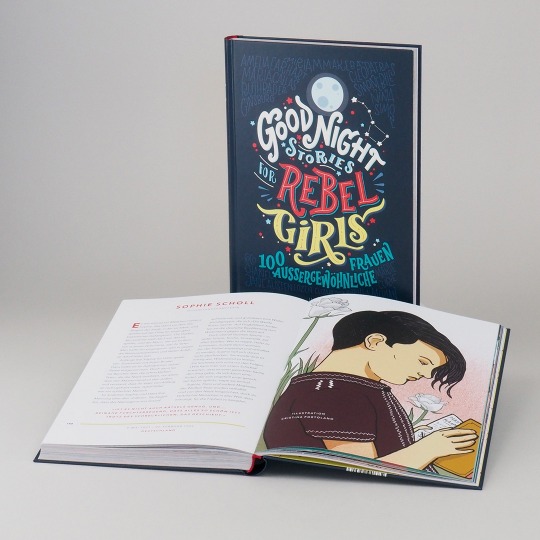
Above: My screenshot of Good Night Stories for Rebel Girls, (2019)
A coherent picture, or is it?
The given research by Filipović uses picture books chosen by skilled educators for younger children between the ages of waddler to early school, the books in that study are a mixture from 1967 to 2013(3).
In my view this study, however, only scratches the surface of the actual topic: the image of the woman in modern societies. Her research shows a glaring imbalance that fits the narrative perfectly but shies away from really forming a conclusion and making a strong statement. And that even though Filipović underlines her research with a broad variety of similar research outcomes highlighting an ongoing problem between gender representation in early childhood picture books.
Looking back into recent years, we find many different movements with this as their main topic, not just #metoo. Gender studies are more common than ever as Filipović’s references show, and pay-gap has long entered mainstream discussion(4).
Women still tend to enter nurturing professions more than risk-taking, managerial or scientific ones, even though they have equal or sometimes better qualifications. Germany just released a governmental study that showed young girls out-matching boys in mathematics at school, yet they perceive themselves as clearly inferior to their male classmates(5).
Looking at depictions of women vs. men in media and advertisement would open a whole other can of worms(6).
And it all fits together so coherently: we are coming from a patriarchal past(7). Just a few generations ago, men ruled everything and women were confined to the kitchen or tending to the children. While we are looking with suspicious eyes at other societies such as the conservative Muslims in Saudi-Arabia, where this is still very strongly the case, we believe to have developed far beyond this point(8).
From 15 between 1967 - 2013 to today's releases
Shifting our focus away from the 15 books in Filipović’s study one might think that - as stated in my introduction - the book publishing market would have adjusted by now. Especially since the Rebel-Girls book became a best-seller(9). Publishers might offer more on this topic, right? On the contrary, as The Observer and The Guardian in an in-depth analysis found out:
‘The most popular picture books published in 2018 collectively present a white and male-dominated world to children, feature very few BAME (black, Asian and minority ethnic) characters and have become more biased against girls in the past year, (...) Male characters continue to dominate the most popular picture books: a child is 1.6 times more likely to read one with a male rather than a female lead, and seven times more likely to read a story that has a male villain in it than a female baddie. Male characters outnumbered female characters in more than half the books, while females outnumber males less than a fifth of the time.’(9)
And even continuing in 2019, in research by Sarah Mokrzycki, Victoria University with 100 best-selling books, similar results are to be found. In her research, books for girls were also highly stereotypical:
‘In the female-led stories, protagonists only showed ambition for traditional feminine pursuits. There were three ballerinas, three princesses and one fashion designer - Claris, a mouse, who “dreamed about clothes” and “read about handbags in Vanity Fair”. (In this story, a misbehaving girl is also chastised for being “neither proper nor prim!”) In comparison, the male-led stories showed protagonists in roles ranging from farmers and chefs to zookeepers and scientists.’(10).
To be fair, her research was for the Australian book retailer Dymocks, a comparable research would need to be done for the UK market.
How far have we come? Conclusion
It all forms a very coherent picture that is not difficult to understand and to accept and which explains every single problem in gender inequality we have - when considering our past, the way we have developed over the last generations, and the problems that very obviously and provenly still linger. We are still fighting the same problems, not to the same extent as women in Saudi-Arabia have to, but they are the exact same problems, yet it appears that resistance and denial are still extremely present.
Maybe stemming from conservative thinkers who still want the ‘good old times’ back when things were easy and women didn’t meddle in their affairs, maybe people just want to live their lives without being bothered by topics like tolerance in nuances (‘Am I still allowed to tell this joke?’, or ‘This picture is funny but now someone tells me it’s sexist? 5 years ago it wasn’t, why now?’). Maybe, though, it’s a much more underlying issue, one that is ingrained into our very beings from the moment we start learning about it. From large factors like the role our mothers portrayed to us as kids, to the value of boys in the schoolyard who can be daring and risk-takers vs. girls who need to be protected and sheltered and rather should play with puppets that they need to take care of and role-playing games, down to the smaller things like an obvious miss-portrayal of genders in the children’s books we read to our kids.
Perhaps this is where the foundation is laid, where we will raise yet another generation that accepts slightly sexist images or objectifying women in advertisement. From there, it’s only a few steps to underpaying and discriminating women and worse. So yes, it does make a difference whether we choose a book about a boy and read it to a girl or if we rather choose to tell the girl a story about an adventurous girl. It does make a difference if the female part in a book is only there to care and the male character is away or depicted as brave and working and fun and successful. Those choices by our parents shaped our future and they will shape the future of our children(11).
It’s not difficult to see or understand this, which is why I wished this study would have put things into context more directly and was more critical. Because there is a lot of reason to be direct, and critical, and loud.
So what can we do as illustrators? Let’s identify and lock away the stereo-typical from our stories. Try to address this matter with our publishers, families, gift our children non-stereo-typical books and toys. Create role-models. But what kind of alternative presentation possibilities could be used for male and female figures? Could custom-made children’s books work as a good alternative? What are other alternatives?
During my research for our presentation on this topic, I stumbled over the campaign ‘Let Toys be Toys’. Their focus is to create a non stereo-typical environment for children in the toy and book industries in the UK. They not only try to convince publishers of books and the toy industry to shift their focus from gender related products to uni-sex products. They also offer help for parents to address their concerns and provide discussion material and lesson plans for teachers(12). I found this to be very encouraging.
Another part that I did not address here but found during my research for the presentation are tests like the Bechdel-Test which was mainly created for movies but can also help to identify books with female protagonists. It’s not only about male-female ratio alone, as The Guardian article quoted above already indicates. We could add more and more tests, such as the BAME test as well(13).
Notes:
Books and articles
Biography retrieved from TU Dublin (2019), Staff Articles. Available at: https://www.dit.ie/llss/people/socialsciences/staffarticles/name176641en.html (Accessed on: 04th November 2019).
Kickstarter (2019), Good night stories for rebel girls. Available at: https://www.kickstarter.com/projects/timbuktu/good-night-stories-for-rebel-girls-100-tales-to-dr (Accessed on: 04th November 2019).
Filipović, Katarina (2018), ‘Gender representation in children’s books: case of an early childhood setting’, Journal of Research in Childhood Education. Routledge, 32(3), pp. 310–325. doi: 10.1080/02568543.2018.1464086.
The gender pay gap among full-time employees was 8.9% in 2019 according to the Office for National Statistics in a recent release from 29 October 2019. Office for National Statistics (2019), Gender pay gap in the UK: 2019. Available at: https://www.ons.gov.uk/employmentandlabourmarket/peopleinwork/earningsandworkinghours/bulletins/genderpaygapintheuk/2019#the-gender-pay-gap (Accessed on: 04th November 2019).
Institut zur Qualitätsentwicklung im Bildungswesen (201), National Assessment Studies and IQB Trends in Student Achievement. Available at: https://www.iqb.hu-berlin.de/bt (Accessed on: 04th November 2019). Cf. Schmoll, H. (2019), ‘Leistungsniveau in Mathe und Naturwissensschaften gesunken’, FAZ Online, 18.10.2019. Available at: https://www.faz.net/aktuell/politik/inland/iqb-bildungstrend-leistungen-in-mathe-und-naturwissensschaften-gesunken-16439167.html (Accessed on: 04th November 2019).
Still to this year advertisements like recently from VW and Philadelphia got banned, cf. BBC (2019) ‘Philadelphia and VW ads banned for gender stereotyping’. Available at: https://www.bbc.co.uk/news/business-49332640 (Accessed on: 04th November 2019).
Not only due to belief system but also family structures, social surroundings, education, and media.
Cf. Power, G., (2019) ‘Things that women in Saudi Arabia still can’t do’, The Week, 3rd of September. Available at: https://www.theweek.co.uk/60339/things-women-cant-do-in-saudi-arabia (Accessed on: 04th November 2019).
Cf. Best Sellers in Philosopher Biographies by Amazon.co.uk: Amazon (2019) ‘Best Sellers in Philosopher Biographies’. Available at: https://www.amazon.co.uk/gp/bestsellers/books/268059/ref=zg_b_bs_268059_1 (Accessed on: 04th November 2019).
Ferguson, D. (2019) ‘’Highly concerning': picture books bias worsens as female characters stay silent’, The Guardian. 13th June. Available at: https://www.theguardian.com/books/2019/jun/13/highly-concerning-picture-books-bias-worsens-as-female-characters-stay-silent (Accessed on: 04th November 2019).
Mokrzycki, S. (2019) ‘I looked at 100 best-selling picture books: female protagonists were largely invisible’, The Conversation, 03rd June. Available at: https://theconversation.com/amp/i-looked-at-100-best-selling-picture-books-female-protagonists-were-largely-invisible-115843 (Accessed on: 04th November 2019).
Cf. McCabe, J., Fairchild, E., Grauerholz, L., Pescosolido, B. A., & Tope, D. (2011). Gender in twentieth-century children’s books: Patterns of disparity in titles and central characters. Gender & Society, 25(2), 197–226. doi:10.1177/0891243211398358. Also cf. Blake, J., & Maiese, N. (2008). No fairytale. The benefits of the bedtime story. The Psychologist, 21(5), 386–388.
Let Toys be Toys (2019). Available at: http://lettoysbetoys.org.uk/ (Accessed on: 04th November 2019).
Cf. Darby, S. (2016) ‘11 children's books that pass the bechdel’, Romper, 17th May. Available at: https://www.romper.com/p/11-childrens-books-that-pass-the-bechdel-test-10544 (Accessed on: 04th November 2019).
Picture(s)
Hanser Literaturverlage (2019), [Screenshot]. Available at: https://www.hanser-literaturverlage.de/buch/good-night-stories-for-rebel-girls/978-3-446-25690-3/ (Accessed on: 04th November 2019).
0 notes
Text
The Not-So-Special Story Behind How To Go Viral – Why These Brands Did It Right
By Senko Duras
Surviving in the world of online content is no easy feat.
Thriving in this world is a Herculean task, and each success has the rest of us wondering how and why.
It seems impossible, yet it happens.
When it comes to going viral, the Pareto principle (also known as the 80-20 Rule) is an extremely helpful reference point. It states that:
80% of output is produced by 20% of input
80% of outcomes are from 20% of causes
80% of contribution comes from 20% of the potential contribution available
In other words, if 20% of your time is spent on content creation, 80% should be spent on content distribution/promotion. This may not always be feasible as some content types will always take longer to produce than others, but as a general rule of thumb, it’s a good way to distribute time across your content tasks.
The reason why? Because often 1% of your content gets 99% of the attention. Viral content defies all odds. It’s an Oscar winner; a slam dunk; a home run.
This post will examine the psychology behind what makes content go viral as well as offering actionable tips to help you achieve the holy grail.
Why do we share?
To unravel why content goes viral, we need to understand why content gets shared in the first place.
So what is it that makes us click ‘share’ instead of ‘like’?
A New York Times study narrowed down the motivations for sharing content into five basic categories:
It’s interesting, but not very actionable. Let’s dig deeper!
What makes content go viral?
When looking for the philosopher’s stone of ‘virality’, you will notice that every study and research conducted about this topic agrees upon four main influencing factors:
Emotional appeal
Value/usefulness
Originality
Outreach
One of the best-known studies is that of Milkman and Berger who explored what exactly makes content spread like wildfire and whether virality can be achieved deliberately.
They found that content that entices high-arousal emotions (either positive or negative) is more effective than content that doesn’t evoke emotions. This finding reflects the common motives for sharing such as the need to connect, feel involved and support causes that matter to us.
They also found that positive content is generally more successful than negative content. That’s a bit surprising, right? I personally would have thought negative content would rule the scene given the much-sought ‘scandal’ factor of negative news. But then again, when you think about it, the act of ‘sharing’ is intrinsically linked to our personal image therefore we want to appear to provide positive value to others.
Tip #1 – Activating high-arousal emotions
So, the first tip when it comes to going viral is to activate high-arousal emotions.
High-arousal emotions can be positive or negative, and they include awe, fear, joy, anger, anxiety, desire, and surprise.
Let’s go through each of these emotions one by one.
Awe
Awe is the wonder and bewilderment we feel when we experience something remarkable. Something we simply cannot resist commenting on or sending forward. It often arises after we experience something we deeply or strongly relate to, or when we read breaking tips or research.
A great example is one of the most viral articles of 2015, ‘To Fall in Love With Anyone, Do This‘, by Mandy Len Catron. The author described her experience of finding an old laboratory experiment that claimed to make complete strangers fall in love, and tested it. Turns out it did, in fact, make her fall in love. Boom! One thing everyone in the world is interested in is love and the article went viral.
It stirred up discussion all over the world and inspired people to either prove or disprove the experiment. This article was an ‘awe bomb’, although it worked on several other emotional fronts including surprise, joy and even anxiety.
Anger
If you poke people with the angry stick, they will work very, very hard to get justice. They will tweet about it, write articles in outrage or rebuttal, and attack you on all virtual fronts to convince the rest of the world that you are wrong.
A great example is an article by ‘The “Content Is King” Myth Debunked’ by Derek Halpern. The old saying that content is king of SEO is widely accepted in today’s world. Derek took this truism and exploded it with data-supported findings. A lot of people tried to discredit his article which resulted in huge amount of backlinks – so the haters actually made him more successful.
Be careful, though, with enticing anger. Using it to your advantage does not mean being deliberately antagonistic or controversial. It means taking a highly debatable topic and finding a logical, well-referenced and original stance on it. It means challenging the accepted status quo using rational, coherent arguments. Also, it’s never advised to base your entire content marketing strategy on this particular emotion.
Surprise/shock
What surprises us? Well, anything that goes against our expectations, really. Enticing the emotion of surprise is all about challenging the accepted status quo. ‘Surprise’ articles are often science-based, revolving around new research findings or simply challenging existing beliefs.
The article ‘Drinking three glasses of champagne ‘could help prevent dementia and Alzheimer’s disease‘ grabbed worldwide attention because not only does it introduce surprising new information, but it justifies a common little ‘vice’ which is the consumption of alcohol for relaxation and socialization.
Joy
The list of what brings joy into our lives and our hearts is long and includes anything that is funny, inspiring or uplifting. This type of content is usually all about personal stories, random acts of kindness, social studies with positive outcomes, and all things cute in life (yes, including cat videos).
For example, the article ‘Penguin swims 5,000 miles every year for reunion with the man who saved his life’ is a cute, heart-warming story that highlights a special relationship between an old man and one of the cutest animals in the world.
Fear/anxiety
Fear is a good one. It’s one of the strongest motivators known to mankind. Even the most rational human beings are bound to succumb to the panic of the surviving reptilian brain and act based on fear from time to time.
Good topic approaches include making people afraid they might be unconsciously committing errors or targeting the ever-present fear of missing out on something (commonly known as ‘FOMO‘).
You can find inspiration for how to entice fear in the article ‘How Images Improve – or Destroy – Conversion Rates‘. This piece emphasizes the importance of images in online content and instills in the reader a momentary fear that there is something they are doing wrong. This fear, in turn, forces you to click… and we all know enough clicks is what makes a piece go viral.
Tip #2 – Making something useful
The next item on the list of viral ‘musts’ is usefulness. It’s simple: content must provide value in one form or another. Content that is useful on a practical level is much more likely to go viral.
Common examples of these type of posts are ‘how to’ guides and informative lists that provide tips and tricks. The only problem with useful content is that there are literally thousands upon thousands of lists and tutorials online already. So, getting yours well-shared is not only about being useful, but also about being more useful than the content that is already out there.
Brian Dean, an SEO specialist and marketer, advises creating a ‘skyscraper post’. The secret lies in finding share-worthy content, creating something ten times better than that, and then reaching out to the right people for promotion.
Another useful tip is, if you are writing an article with positive but vague ideas, wrap up your article with a list of concrete steps that you want your readers to take. Concrete actions lead to results – and results help you be remembered and referred back to.
Tip #3 – Original: to be or not to be?
Regarding viral content, being ‘original’ may or may not be good advice. In fact, the most successful creators of viral content spend heaps of time studying other viral results and mimicking them in their own content. So where does that leave originality?
A good example of originality repurposed is a post from BuzzFeed that used the romanticized inconsistencies in the famous Penguin stories to create their version of the well-received post: ‘A Scientist Says That Story About The Penguin Who Swims Home To His Friend Was Misreported‘.
It’s hard to believe, but when you think about it, it’s true. Originality does not reside as much in the originality of the idea or information, but in the approach and representation. You don’t always have to go elsewhere to look for trends to evaluate, just improve and reuse your own content.
Tip #4 – Reach for outreach
The last (but not least) law of the jungle when it comes to going viral is: no exposure = no likes. Simply creating content, posting it and hoping for the best will not cut it these days. There is too much fluff online already. By the time Google crawlers reach you, you will be retired in the Bahamas. If you want your content to get noticed today, you need to dive deep into social media and reach out to the right people.
Mandy Lee Catron’s love experiment would never have become world-famous if she had stuck to her little blog with its decent but small reader-base. Instead, by guest-posting the article to The New York Times, she got the necessary exposure for her content to become viral.
So, whether you decide to guest post or promote your content piece above and below social media, exposure cannot be overlooked as a necessary step in the process.
Summing up
Making your content viral is not an easy task, but it is not impossible either. With attention, evaluation and practice, your article or video can be the next storm that rushes through news feeds and Twitter streams all over the world.
Guest Author: Passionate about digital marketing, entrepreneurship, growth and travel, Senko Duras is also the co-founder of Diversis Digital and Point Visible. Loves testing new ideas, projects with unclear specifications and fighting pressure with a chilled out attitude.
The post The Not-So-Special Story Behind How To Go Viral – Why These Brands Did It Right appeared first on Jeffbullas’s Blog.
The post The Not-So-Special Story Behind How To Go Viral – Why These Brands Did It Right appeared first on Make It With Michael.
from The Not-So-Special Story Behind How To Go Viral – Why These Brands Did It Right
0 notes